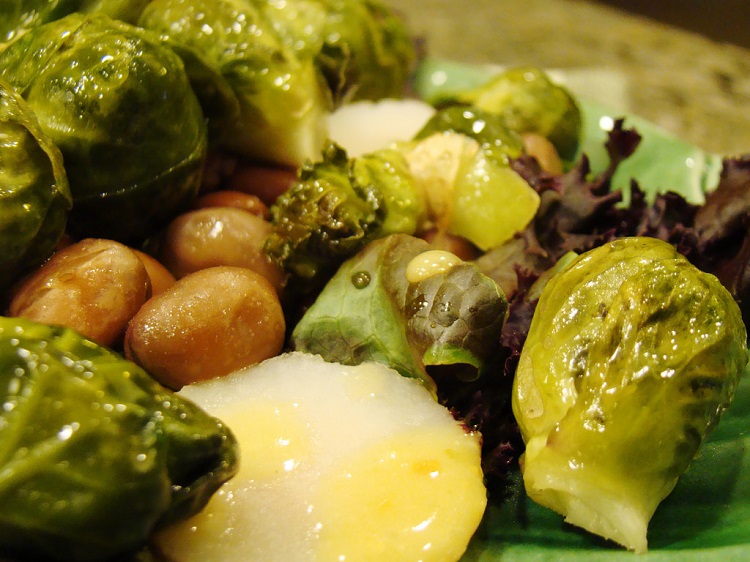Edible Synthetic Blocks Bitter Taste
(Inside Science) -- Can't stand your grandmother's bitter Brussels sprouts? Instead of dousing them in butter or feeding them to the dog, you may soon have a scientific option codenamed GIV3727.
The recently discovered molecule is a bitter blocker that contains just the right combination of carbon, oxygen, and hydrogen atoms to protect your tongue from bitter substances. It's part of the latest fashion in the food industry -- synthetic taste compounds pieced together in a laboratory that work like the volume knob on a stereo, turning the sensitivity of your taste buds up or down.
"With the synthetic approach, we can dream up chemical structures beyond what nature gives us to block different tastes," said Jay Slack, a molecular biotechnologist at Givaudan Flavors Corp. in Cincinnati. The company published the molecule's structure in Current Biology on May 27.
Our Bitter Past
The race to create these taste molecules at Givaudan and other biotechnology companies is a battle against the 400 million years of evolution that make the human tongue what it is today.
Your tongue is packed with 10,000 taste buds, each as wide across as a human hair. Every taste bud contains an assortment of 50-150 taste cells, each of which is specialized for one of the five basic tastes: salty, sweet, sour, bitter, or savory. Food particles stick to the tiny taste receptors on these cells, triggering a chain of events inside the cell that lead to experience of tasting in the brain.
The first creature with bitter taste receptors similar to ours lived about 400 million years ago. Modern humans, birds, fish, and other mammals all carry similar genes from this shared ancestor, genes that allow our bodies to make taste receptors.
Scientists first identified taste receptor molecules in 1998, when Charles Zucker of the University of California, San Diego found that rats lacking a single gene were unable to taste sugar. After the Human Genome Project in 2003, Zucker identified all human genes that code for our specialized taste receptors.
We have one type of receptor devoted to sweet, one for salt, one for sour, and one for savory -- but, at the latest count, there are 25 different receptors for bitterness. Scientists believe this variety of bitter receptors capable of detecting thousands of different compounds helps to protect us since poisons and toxins found in nature tend to be bitter tasting.
"It's a very old evolutionary principle," said Wolfgang Meyerhof, geneticist at the German Institute of Human Nutrition in Potsdam-Rehbruecke who worked with Givaudan. "Taste helps us to avoid noxious substances and gives an attractiveness to nutrients."
The Sweet Future
Many foods and drinks -- especially diet drinks made with artificial sweeteners -- also have a bitter taste or aftertaste that the food industry would like to eliminate.
"We wanted to develop a bitter blocker that targets a single receptor," said Meyerhof.
To find GIV3727, Givaudan recruited millions of tiny tongue-like taste testers -- cells genetically engineered to be covered in human bitter receptors. These cells glow when exposed to bitter compounds and can be used to check the effectiveness of hundreds of thousands of potential bitter blockers much more quickly and cheaply than human taste testers.
Slack screened more than 170,000 molecules to find GIV3727, a bitter "antagonist" that sticks to several different bitter receptors and blocks bitter food compounds from attaching.
After passing safety tests and being certified by the Food and Drug Administration as "Generally Recognized as Safe," the molecule was tested on human volunteers. People who tried the bitter blocker along with artificial sweeteners acesulfame K and saccharin, which are hundreds of time sweeter than sugar, reported tasting much less bitterness but just as much sweetness.
Years ago, scientists discovered another taste compound -- adenosine monophosphate -- which interferes with the molecular pinball inside of our taste cells to prevent both bitter and sweet tastes. It is used to dull the bitterness of some drugs, which is why some medicines taste so sweet: manufacturers add concentrated sweeteners to overcome the effects that it has on sweetness.
But Danielle Reed, a geneticist at the Monell Chemical Senses Center in Philadelphia who was not involved in the research, said that Givaudan's achievement was a first.
"There's never been a demonstration that there is a specific bitter blocker that acts as an antagonist to a bitter receptor," said Reed.
Slack would not reveal Givaudan's clients, but he did say that several major food companies have purchased GIV3727, which may be coming to supermarket shelves in the future in everything from diet drinks to mouthwash to sugar-free bubblegum.


